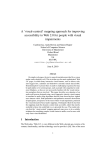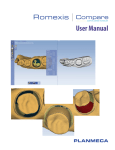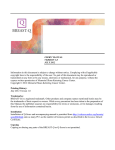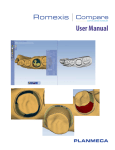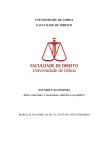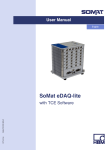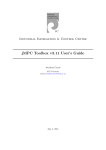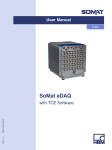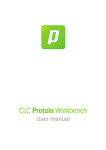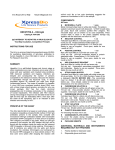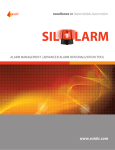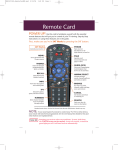Download "user manual"
Transcript
EDAQ Evaluation of Daily Activity Questionnaire: User Manual v1 © A Hammond, A Tennant, S Tyson, U Nordenskiold 2014 1 2 3 4 Copyright © A Hammond , A Tennant , S Tyson , U Nordenskiold 2014 The Evaluation of Daily Activity Questionnaire (EDAQ) User Manual: Version 1 1 2 3 4 University of Salford, University of Leeds, University of Manchester, , University of Gothenburg. The English version of the EDAQ is adapted from the Swedish EDAQ developed by Ulla Nordenskiold PhD, Sahlgrenska Academy, University of Gothenburg, Sweden. Acknowledgements: The English EDAQ was initially developed and tested in RA. The EDAQ and most of the work to develop this manual were funded by Arthritis Research UK grant 18497. Subsequently, the EDAQ was then tested in other musculoskeletal conditions and this work, along with further development of this manual, was supported by the United Kingdom Occupational Therapy Research Foundation. The authors would like to thank: Ruth Hawkins (National Rheumatoid Arthritis Society (NRAS) member), members of the Bolton and Derby NRAS groups, Dr Lynne Goodacre (North West NIHR Research Design Service), Dr Gunnel Sandqvist, Dr Ragnhild Cederlund (Lund University, Sweden), Dr Ingrid Thyberg (Linkoping University, Sweden) and members of the North West College of OT Specialist Section Rheumatology for advice and feedback on EDAQ content during the English EDAQ development; Rachel Gill, Rachel Shuttleworth, Dr Yeliz Prior, Rob Peet and Kate Woodward-Nutt (University of Salford) and Katie Hackett (University of Newcastle) for assistance with data collection and management; Robin Waxman, Mike Horton and Vikki Lane, (Psychometrics Laboratory, University of Leeds) for assistance with Rasch analysis and EDAQ layout. The Evaluation of Daily Activity Questionnaire (EDAQ) and the EDAQ Manual (v1 and any future versions) are both available under a Creative Commons license (Attribution-NonCommercialNoDerivs CC BY-NC-ND) and can be copied for clinical, research and educational purposes. No part of the EDAQ or EDAQ manual can be modified without prior permission of the lead author. For commercial use, electronic or hard copy or queries, contact the lead author: [email protected] or [email protected] Obtaining the EDAQ and the EDAQ Manual: The two forms of the Evaluation of Daily Activity Questionnaire (EDAQ: i.e. including Parts 1 and 2; or Parts 1,2 and 3) and the EDAQ Manual v1 (and future updated versions including Rasch Transformation tables for other musculoskeletal conditions) are available for download at: http://usir.salford.ac.uk/view/authors/index.H.html Search for Hammond and look under “Monographs”. Publications related to the EDAQ are located under “Articles.” Table of Contents 1 Introduction 1 2 EDAQ content 2 3 Time taken to complete the EDAQ 3 4 Who is it for? 4 5 People with arthritis’ and occupational therapists views of the EDAQ 4 6 Clinical Use 5 7 Research Use 6 8 Scoring the EDAQ 6 9 Analysing EDAQ data 8 10 Availability of the EDAQ 9 References 10 Appendix 1: Examples of Scoring the EDAQ 11 Appendix 2: Rasch Transformation Table for Rheumatoid Arthritis 15 1. Introduction The Evaluation of Daily Activity Questionnaire (EDAQ) is a self-report assessment. It evaluates, in detail, a person’s daily activity abilities with and without using ergonomic solutions (ie using alternate movements and positions, planning, activity simplification, pacing, assistive devices, gadgets and equipment) or help. It includes items related to the International Classification of Functioning, Disability and Health (ICF) body functions, activity/ participation and environment (World Health Organisation, 2001). The EDAQ was originally developed and tested in the mid-1990’s with women with rheumatoid arthritis (RA) in Sweden (Nordenskiold et al. 1996, 1998), where it is used clinically and for clinical and epidemiological research (Cederlund et al, 2001, 2007; Sandqvist et al, 2004; Thyberg et al, 2004, 2005). We have translated the EDAQ into English using standard methods (Beaton et al, 2000). People with a range of arthritis and musculoskeletal conditions in the UK contributed to its’ cross-cultural adaptation by identifying problematic activities, and they decided which activities to include and omit. This ensured content is relevant and important to people with arthritis, as well as including relevant activities for the 2010’s. Rheumatology occupational therapists also contributed to identifying which activities should be included. The EDAQ can be used for clinical, audit and research purposes. For all uses, it is completed by the person in their own time, usually at home. They can take breaks or do this over a couple of days if they wish. This allows reflection on abilities and what they want help with, as well as avoiding tiredness whilst filling it in. By completing it at home, less time is spent during therapy appointments identifying problems, allowing more time to focus on solutions. The EDAQ facilitates collaboration between the person with arthritis/ musculoskeletal conditions and the therapist. The EDAQ was originally designed as an Occupational Therapy assessment, for clinical and research purposes. However, it can also be used to evaluate Physiotherapy clinical practice and research, as it includes both activity and mobility limitations. It can also be used to evaluate the effects of multidisciplinary rehabilitation and self-management education, and to evaluate pharmacological interventions, if a more detailed activity/mobility assessment is required. 1 The EDAQ has been tested for reliability and validity in: Rheumatoid Arthritis Osteoarthritis Ankylosing Spondylitis Systemic Lupus Erythematosus Systemic Sclerosis Chronic Pain conditions (including back pain, neck pain, chronic widespread pain, fibromyalgia) Chronic upper limb conditions (including carpal tunnel, de Quervain’s, shoulder conditions) Primary Sjogren’s Syndrome. Abstracts of research related to the EDAQ in RA can be found in Hammond et al 2010a,b, 2011, 2012a,b. Full articles are in preparation/review. The relevance of EDAQ content to people with musculoskeletal conditions has been evaluated (Hammond et al, 2010) and reliability and validity abstracts / articles are also in preparation. Please contact the lead author for further information about ongoing publications in the above conditions. 2. EDAQ Content The EDAQ includes three parts: Part 1: evaluates common effects of arthritis. 10 numeric rating scales evaluate: mood, pain when resting, pain when moving, stiffness, limitations in joint movement, fatigue, worry, sleep problems, and satisfaction with life. Part 2: evaluates 138 daily activities. Section A: asks ability without using ergonomic methods (ie alternative methods: joint protection, such as: using different movement patterns and positioning; pacing; planning; task simplification; assistive devices, aids and gadgets) or help. Section B asks ability with ergonomic methods; and to describe the method used. There are 14 domains: 1. Eating /Drinking 2. In the Bathroom/ Personal Care 3. Getting Dressed/ Undressed 4. Bathing/ Showering 5. Cooking 2 6. Moving Around Indoors 7. Cleaning the House 8. Laundry / Clothes Care 9. Moving and Transfers 10. Communication 11. Moving Around Outside/ Shopping 12. Gardening/ Household Maintenance 13. Caring 14. Hobbies, Leisure and Social Activities. The last three domains were developed and added to the English EDAQ following feedback from people with arthritis that these should be included. Part 3 Optional: asks about opinions and use of common assistive devices. This part is not essential and has not been psychometrically tested. Finally: five questions ask about: use of orthoses; which assistive devices are valued most; attitudes to using assistive devices; actions taken to self-manage arthritis; and the most important thing the person wishes to continue to do. Two forms of the EDAQ are available: with and without Part 3. Normally, only parts 1 and 2 are used, unless information about assistive device use is essential. 3. Time taken to complete the EDAQ This will vary with: Number of difficult activities, as the person records alternate methods/ assistive devices/ gadgets used. Pain Fatigue Hand function Concentration. During testing of the full EDAQ (i.e. parts 1, 2 and 3), the time taken varied from 18 to 78 minutes (median 40, IQR 28 – 59 minutes). To complete the revised EDAQ, ie just parts 1 and 2, takes most people about 25 to 30 minutes. Consequently, people should take the 3 EDAQ home to complete in their own time. This allows reflection on abilities and avoids them feeling pressurised to complete it quickly. It has not been tested as an interview. 4. Who is it for? The EDAQ can be used in a wide range of rheumatological conditions (see page 2). In psychometric testing, over 80% of eligible patients with RA consented to take part, most of whom then completed the EDAQ. Of those unwilling to take part, reasons were: not wanting to take part in research; too ill; family members unwell; too busy; and, a few, did not like long questionnaires. Clinically, this suggests some two-thirds of people with RA, or more, would be willing and able to complete the EDAQ. The EDAQ is NOT for everyone. Some people have insufficient reading ability, concentration or desire to complete questionnaires. We found 8% of people requested additional verbal instructions in how to complete the EDAQ (over and above the written instructions already included within the EDAQ). This group were more likely to have severe activity limitations and/ or poorer quality of life. Following additional instructions, this group were just as able to complete the EDAQ as those not receiving verbal instructions. If people are clinically depressed and have more severe difficulties, please consider its appropriateness for them, as completion will heighten their awareness of difficulties. Emphasise to them how it will assist them and you to collaboratively identify solutions. 5. People with arthritis’ and occupational therapists’ views of the EDAQ. In our study, most (83%) people with RA considered the EDAQ helpful or very helpful for discussing everyday problems with an OT. Most (87%) replied it had about the right amount of activities. Comments from people with RA included: “It was very thorough and would be good for outlining level of difficulty and needs. It’s easy once you read the instructions carefully.” “The EDAQ covered everything.” “Yes it was good that it includes what help and assistance the person requires included in it.” 4 Comments from Rheumatology OTs were: “It’s more patient oriented… It takes out the time of having to actually go through it all with them.” “A lot of our patients say the time they spent with OT was fleeting…filling this out would be very thorough.” “You identify the talking points straight away, which helps focus it [the treatment plan] a lot more.” Using the EDAQ can save therapists’ time in assessing, allowing more time for providing solutions. This can help improve efficiency of and satisfaction with OT services. 6. Clinical use The occupational therapist introduces the assessment to the person. For example: “The EDAQ (Evaluation of Daily Activity Questionnaire) helps us understand about your abilities and problems doing your daily activities. You may have noticed using aids, everyday gadgets, equipment or even different ways of doing things (such as using two hands) reduces some of these problems. Sharing your problems and solutions with us, helps us to help you. Please complete the EDAQ in your own time at home. Take a break or two if you want. The first part asks how arthritis affects you, for example, about pain and fatigue. The second part asks about your ability doing daily activities in detail. (Open up questionnaire to show example on page 7). Here is an example of how it’s filled in. Every question is answered twice. In Section A, tick how you manage every activity on your own, without using any different methods, such as using two hands, gadgets or help. Remember, if you now can’t do an activity because of your arthritis, tick “unable to do.” Only tick “not applicable” if you normally have never done that activity. Then tick in the middle columns if you use a gadget or other method, or if you have help doing it. If you tick No or Help, you don’t need to do Section B. If you do tick Yes: fill in Section B. Here are some examples. (Explain some of the examples on page 7 to check the person knows what to do). Please bring it with you to our next appointment.” During the appointment, when reviewing Part 2, only those activities causing difficulty need be discussed to find solutions. 5 7. Research Use The majority of people in our studies were able to complete the EDAQ without having any additional verbal instructions. We recommend that: if recruiting with the person present, ask them to read the instructions and example provided and then ask if they need verbal instructions; if recruiting via telephone/ mail only, provide a contact telephone number so that people can ask for help if they require this. 8. Scoring the EDAQ Total scores for each domain (separately for sections A and B) are created by summating item scores within the domain, giving an indication of the person’s ‘overall ability’ in that domain both without and with ergonomic solutions. Rasch analysis has confirmed it is appropriate to produce summated scores from the ordinal data produced in the EDAQ Part 2. Part 1: each numeric rating scale is scored separately by recording the number circled. Part 2: Section A: If an item is scored as: Not applicable = 0. No difficulty = 0; some difficulty = 1; much difficulty = 2; unable to do =3. Add the scores of each item in a domain to provide the total Section A domain score. Part 2: Section B: If an item is scored as: If ticked “Yes” to use of alternate methods and aids and completed section B: score as: No difficulty = 0; some difficulty = 1; much difficulty = 2; unable to do =3. If ticked either “No” to using aid/other method, “Help” or Section B is not completed: the section B score is the same as in section A. Section B scores are calculated by adding both i) section B domain item scores using ergonomic solutions and ii) if none are used, then performance was unchanged). 6 that item’s A score is added (as Differences between total section A and B domain scores denote the impact of ergonomic solutions. See the scoring example in Appendix 1. Domains can each be scored individually, as each domain is reliable and valid. Additionally, total domain scores can be combined into two components: 1. SELF-CARE Score: Domains 1+2+3+5+7+8+10 2. MOBILITY/ PARTICIPATION Score: Domains 4+6+9+11+12 Domains 13 and 14 are not included as there are often higher numbers of “not applicable” responses in both the Caring (due to few or no childcare responsibilities in many older respondents) and Hobbies domains (due to greater variation in personal interests). Part 3: data is investigated descriptively. Dealing with missing scores: Missing scores mean a total Section A domain score cannot be calculated for any given domain for that person. It is not statistically appropriate to use mean scores as an alternative. Please make every effort to ensure the EDAQ is completed correctly. To avoid the problem of missing data: Clinical practice: ensure missing items are completed during your assessment review. Research: if possible, telephone participants to obtain missing data, or return a copy of the pages with the missing items to the participant and request these are completed and returned as it is very important to obtain all their information. Alternatively, you can use multiple imputation and then conduct statistical analysis of summed domain scores. During EDAQ development, we tested several appearances for the EDAQ: ticking a grid, squares or circles. We also tested two layouts: a) The same layout as the Swedish EDAQ, i.e. without the central columns asking people to tick if they use Alternate methods/aids and/ or Help b) Revised layout, with these central columns. 7 Participants preferred the grid layout. The latter format, with central columns, reduced the amount of missing data from participants. In testing in RA, we found 4% of the possible domain scores could not be calculated due to missing data. People with severe activity limitations and poorer quality of life were more likely to be those with some missing scores. In clinical practice, when the person returns with the questionnaire, please always check that all items are completed. Please assist the person to complete any missing items. This will ensure you can fully score the EDAQ. 9. Analysing EDAQ data As EDAQ data is ordinal, non-parametric tests are used to identify differences in scores, for example: between Sections A and B (without and with ergonomic solutions and help); before to after treatment; or between groups. In research, if required, data in Part 2 can be transformed into interval data using the Rasch Transformation Table for RA (Appendix 2), allowing use of parametric tests when applicable. Rasch Transformation Tables for use with other conditions will be available from the lead author during 2014. Rasch transformation of an individual’s domain score is only valid when their domain data are complete. Similarly, Rasch transformation of an individual’s component score is only valid when their domain total scores within the component are complete. You cannot impute missing data and then Rasch transform domain scores for analysis for that individual. An SPSS EDAQ data entry file and SPSS coding/scoring instructions are available from the lead author. 8 10. Availability of the EDAQ The two forms of the EDAQ (i.e. including Parts 1 and 2; or Parts 1,2 and 3) and the EDAQ Manual v1 (and updated manual(s) including Rasch Transformation tables for other musculoskeletal conditions) are available for download at: http://usir.salford.ac.uk/view/authors/index.H.html Search for Hammond (Monographs). Publications related to the EDAQ are located under Articles. NB. Normally the EDAQ Parts 1 and 2 only are used in clinical practice and research. The EDAQ is available under a Creative Commons license (Attribution-NonCommercialNoDerivs CC BY-NC-ND). The EDAQ cannot be altered without prior permission of the authors. Please contact the lead author if you: Need an electronic copy in Word for clinical, research or other uses, or for commercial use. For the latter, there may be a charge to use the EDAQ depending on the project and funder. want to psychometrically test the EDAQ for other conditions or in other languages, as we can advise you on this process. If you do so, the resulting version of the EDAQ must be made available using a Creative Commons license. have any queries about using the EDAQ or have any feedback about using the EDAQ in clinical practice and research. [email protected] or [email protected] 9 References: Beaton DE, et al (2000). Guidelines for the process of cross-cultural adaptation of self-report measures. Spine 25(24):3186-3191. Cederlund R, Nordenskiold U, Lundborg G (2001). Hand-arm vibration exposure influences performance of daily activities. Disability and Rehabilitation 23(13):570-577. Cederlund R, Iwarsson S, Lundborg G (2007). Quality of life in Swedish workers exposed to hand-arm vibration syndrome. Occupational Therapy International 14(3):156-169. Hammond A, Gill R, Nordenskiold U, Thyberg I, Cederlund R, Tyson S, Tennant A, Sandqvist G, Hawkins R (2010a). The development of a prototype UK- Evaluation of Daily Activity Questionnaire: linguistic and cross-cultural validation. Ann Rheum Dis; 69(Suppl3):734 Hammond A, Gill R, Tyson S, Nordenskiold U, Tennant A (2010b) Development of the UK Evaluation of Daily Activity Questionnaire: Phase 2:cognitive debriefing. [abstract]. Arthritis Rheum;62 Suppl 10 :2063 DOI: 10.1002/art.29828 Hammond A, Tennant A, Tyson S, Nordenskiold U, Gill R (2011) Development of the United Kingdom Evaluation of Daily Activities Questionnaire in Rheumatoid Arthritis using Rasch Analysis. Arthritis & Rheumatism 63(10):Supplement S1000:2555 Hammond A, Tyson A, Tennant A. Nordenskiold U, Greenhill Y (2012a) Development of the Evaluation of Daily Activity Questionnaire (EDAQ) in Rheumatoid Arthritis: psychometric testing. Annals of the Rheumatic Diseases 71 (Suppl 3):753 Hammond A, Gill R, Tyson S, Tennant A, Nordenskiold U (2012b) Development of the Evaluation of Daily Activity Questionnaire (EDAQ) in Musculoskeletal conditions: Phase 1. Rheumatology 51(Suppl 3): 57 Hammond A and Tyson S (2012). Activity Limitations Experienced by People with Rheumatoid Arthritis On Biologic Medications and Their Use of Ergonomic Methods. Arthritis & Rheumatism 64(10) Supplement: S1030 Nordenskiold U, Grimby G, Hedberg M et al (1996). The structure of an instrument for assessing the effect of assistive devices and altered working methods in women with rheumatoid arthritis. Arthritis Care and Research 9:21-30. Nordenskiold U, Grimby G, Dahlin-Ivanoff S (1998). Questionnaire to evaluate the effects of assistive devices and altered working methods in women with rheumatoid arthritis. Clinical Rheumatology 17:616. Sandqvist G, Eklund MA, Akesson A, Nordenskiold U (2004). ADL activities and hand function in women with scleroderma. Scandinavian Journal of Rheumatology 33:102-7. Thyberg I, Hass UAM, Nordenskiold U, Skogh T (2004). Survey of the use and effect of assistive devices in patients with early rheumatoid arthritis: a two-year follow-up of women and men. Arthritis Care and Research 51(3):413-421. Thyberg I, Hass UAM, Nordenskiold U, Gerdle B, Skogh T (2005). Activity limitation in rheumatoid arthritis correlates with reduced grip force regardless of sex: The Swedish TIRA Project. Arthritis Care and Research 53(6):886-896. World Health Organisation (WHO) (2001). International Classification of Functioning, Disability and Health. http://www.who.int/classifications/icf/en/ Downloaded 12.12.13 10 APPENDIX 1: EXAMPLE OF SCORING THE EDAQ. 11 Please tick () to indicate your ability carrying out the activities listed below during the last two weeks. Please fill in both sections: A: ‘How do you do it without using an aid/gadget, alternate method or help?’ If you do not normally do the activity, tick “not applicable”. B: ‘How else do you do it with an aid/gadget or alternate method?” Fill in the middle columns. Leave B blank if you tick “no” or “have help.” 5. COOKING A. How do you do it without an aid/ gadget, Do you use Have help/ an aid or alternate method or help? Not Without Some Much Unable Score Applicable difficulty difficulty difficulty to do 2 2.Set the table/ carry plates, cups etc 2 3.Peel and chop vegetables 2 4.Carry a full pan to/ from the cooker 0 2 Easy Peeler; bigger knife. Use frozen. 0 2 6.Remove heavy items (e.g. bag of sugar) from top cupboards 2 Wear splint; keep heavy items low down 0 1 2 8.Take things in/out of oven Perch stool 1 5.Drain water from a saucepan (e.g. vegetables, pasta) 7.Baking (eg. Cakes, bread, pastry) Someone Please describe below which Without Some Much Unable Score does it aid/s or other method/s you difficulty difficulty difficulty to do No for me use? other method? Yes 1.Stand while working in the kitchen B. If yes, how else do you do it with an aid/gadget or alternate method? 1 0 2 12 2 Please tick () to indicate your ability carrying out the activities listed below during the last two weeks. Please fill in both sections: A: ‘How do you do it without using an aid/gadget, alternate method or help?’ If you do not normally do the activity, tick “not applicable”. B: ‘How else do you do it with an aid/gadget or alternate method?” Fill in the middle columns. Leave B blank if you tick “no” or “have help.” 5. COOKING (continued) A. How do you do it without an aid/ gadget, Do you use Have help/ an aid or alternate method or help? Not Without Some Much Unable Score Applicable difficulty difficulty difficulty to do other method? Yes 9.Wash up 10.Put crockery/pans etc into kitchen cupboards 11.Use a kettle (e.g. fill, pour) 2 No Someone does it for me B. If yes, how else do you do it with an aid/gadget or alternate method? Please describe below which Without Some Much Unable Score aid/s or other method/s you difficulty difficulty difficulty to do use? Dishwasher 0 1 1 2 2 12.Turn cooker knobs 0 0 13.Open fridge door 0 0 14.Prepare and cook a snack and/or a meal 2 Total Score: Section A = 20 Gadgets help, still tired 1 Total Score: Section B = 12 13 Please tick () to indicate your ability carrying out the activities listed below during the last two weeks. Please fill in both sections: A: ‘How do you do it without using an aid/gadget, alternate method or help?’ If you do not normally do the activity, tick “not applicable”. B: ‘How else do you do it with an aid/gadget or alternate method?” Fill in the middle columns. Leave B blank if you tick “no” or “have help.” 8. LAUNDRY/ CLOTHES CARE A. How do you do it without an aid/ gadget, alternate method or help? Not Without Some Much Unable Score Applicable difficulty difficulty difficulty to do Do you use an aid or other method? Have B. If yes, how else do you do it with an aid/gadget or alternate help/ method? Someone Please describe below which Without Some Much Unable Score does it aid/s or other method/s you difficulty difficulty difficulty to do for me use? Yes No 1.Do the hand washing 2.Use a washing machine (e.g. load and unload) 2 4.Plug in and pull out a plug 0 3.Hang out washing Use wash machine for everything 2 2 0 Use tumble drier for everything Plug pulls 0 0 Husband does 5.Put up an ironing board 1 6.Iron 1 7.Do small repairs e.g. hemming, buttons 1 1 8.Cut cloth and/ or use scissors 1 1 1 9.Pick up pins/needles 0 Little and often; wear wrist splint; only what need to Total Score: Section A = 11 magnet 1 0 0 Total Score: Section B = 14 3 APPENDIX 2: RASCH TRANSFORMATION TABLE FOR RHEUMATOID ARTHRITIS. Domains 1-12 (Self-Care and Mobility/Participation Components): pages 17-24 Domains 13 & 14: page 25 15 Key: RAW = summed domain/ component score from ordinal (raw) scores Rasch T = Rasch transformed score Examples: Eating domain: if score = 20, the Rasch transformed score = 16.5 Self-Care component: If score = 49, the Rasch transformed score = 75.5 Bathing domain: if score = 27, the Rasch transformed score = 23.4 Mobility/Participation component: If score = 101, the Rasch transformed score = 74.6 The Rasch Transformation Table is available in an Excel file from the lead author. Note: this table is for use in Rheumatoid Arthritis. Please contact the lead author for tables for other conditions. An updated version of this manual with these other tables will be available in future. 16 Selfcare Self-Care RAW 0 1 2 3 4 5 6 7 8 9 10 11 12 13 14 15 16 17 18 19 20 21 22 23 24 25 26 27 28 Rasch T 0.0 17.0 27.4 33.7 38.2 41.6 44.3 46.6 48.6 50.3 51.8 53.2 54.4 55.6 56.6 57.6 58.5 59.4 60.2 60.9 61.7 62.4 63.0 63.7 64.3 64.9 65.5 66.0 66.6 Mobility Eat 0.0 2.5 4.3 5.5 6.5 7.3 8.1 8.8 9.5 10.1 10.7 11.2 11.8 12.3 12.9 13.4 13.9 14.5 15.1 15.8 16.5 17.2 18.0 18.9 19.9 21.0 22.1 23.4 25.0 Bathroom 0.0 2.5 4.2 5.2 6.1 6.8 7.4 7.9 8.4 8.8 9.2 9.6 9.9 10.3 10.7 11.0 11.4 11.8 12.2 12.6 13.1 13.6 14.2 14.9 15.6 16.5 17.4 18.4 19.6 Dress 0.0 2.7 4.5 5.8 6.8 7.7 8.5 9.3 10.1 10.9 11.8 12.6 13.5 14.4 15.3 16.2 17.1 18.0 18.9 19.8 20.6 21.4 22.2 22.9 23.6 24.3 25.0 25.6 26.4 Cook 0.0 3.3 5.5 7.0 8.2 9.2 10.2 11.0 11.9 12.7 13.4 14.2 14.9 15.6 16.3 17.0 17.7 18.3 19.0 19.6 20.3 20.9 21.5 22.2 22.8 23.5 24.1 24.8 25.5 Mobility Clean Laundry Commun RAW Rasch T Bathing Indoor Transfer Outdoor Garden 0.0 0.0 0.0 0 0.0 0.0 0.0 0.0 0.0 0.0 2.8 2.6 1.0 1 11.8 3.4 2.9 1.7 3.4 3.5 4.8 4.4 1.7 2 19.2 5.8 4.9 3.0 5.8 5.9 6.2 5.6 2.3 3 23.8 7.4 6.3 3.9 7.4 7.7 7.2 6.6 2.8 4 27.1 8.7 7.4 4.7 8.7 9.1 8.2 7.3 3.2 5 29.6 9.8 8.4 5.5 9.8 10.3 9.0 8.1 3.7 6 31.7 10.8 9.3 6.2 10.8 11.3 9.7 8.7 4.2 7 33.5 11.8 10.1 7.0 11.7 12.3 10.3 9.4 4.9 8 35.0 12.6 10.9 7.8 12.5 13.1 10.9 10.0 5.6 9 36.4 13.3 11.6 8.7 13.2 13.8 11.5 10.5 6.4 10 37.7 14.0 12.2 9.5 13.9 14.3 12.0 11.1 7.4 11 38.8 14.7 12.9 10.4 14.5 14.8 12.5 11.7 8.4 12 39.8 15.3 13.4 11.2 15.1 15.3 13.0 12.3 9.6 13 40.8 15.8 14.0 12.0 15.6 15.7 13.5 12.9 10.9 14 41.7 16.3 14.5 12.9 16.1 16.1 14.0 13.5 12.3 15 42.5 16.8 15.1 13.7 16.5 16.5 14.5 14.1 13.8 16 43.3 17.3 15.6 14.7 17.0 17.0 15.1 14.7 15.7 17 44.1 17.8 16.1 16.1 17.4 17.4 15.7 15.4 18.0 18 44.8 18.2 16.6 18.0 17.8 18.0 16.3 16.1 19 45.5 18.7 17.1 18.2 18.7 17.0 16.9 20 46.2 19.2 17.6 18.6 19.6 17.7 17.7 21 46.8 19.7 18.2 19.0 21.0 18.6 18.5 22 47.2 20.2 18.8 19.4 19.5 19.5 23 48.0 20.7 19.4 19.9 20.7 20.6 24 48.6 21.3 20.0 20.4 22.1 22.0 25 49.2 21.9 20.7 20.9 24.1 24.1 26 49.7 22.6 21.5 21.4 27.0 27.0 27 50.2 23.4 22.3 22.0 28 50.7 24.2 23.2 22.7 17 SelfCare Self-Care Mobility Mobility RAW 29 30 31 32 33 34 35 36 37 38 39 40 41 42 43 44 45 46 47 48 49 50 51 52 53 54 55 Rasch T 67.1 67.6 68.1 68.6 69.0 69.5 69.9 70.4 70.8 71.2 71.6 72.1 72.5 72.9 73.2 73.6 74.0 74.4 74.8 75.1 75.5 75.8 76.2 76.5 76.9 77.2 77.6 Eat Bathroom 27.1 20.9 30.0 22.2 23.8 25.4 27.2 29.3 32.1 36.0 Dress 27.1 28.0 29.1 30.7 33.0 Cook 26.2 27.0 27.7 28.5 29.2 30.0 30.9 31.8 32.7 33.8 35.0 36.5 38.8 42.0 Clean Laundry Commun RAW 29 30 31 32 33 34 35 36 37 38 39 40 41 42 43 44 45 46 47 48 49 50 51 52 53 54 55 18 Rasch T Bathing Indoor Transfers Outdoor Garden 51.2 25.2 24.2 23.4 51.7 26.3 25.2 24.2 52.1 27.8 26.3 25.1 52.6 29.9 27.5 26.1 53.0 33.0 28.9 27.1 53.4 30.5 28.3 53.9 32.8 29.6 54.2 36.0 31.0 54.6 32.9 55.0 35.4 55.4 39.0 55.7 56.1 56.4 56.8 57.1 57.4 57.7 58.0 58.3 58.6 58.9 59.2 59.5 59.8 60.1 60.3 SelfCare RAW Self-care Rasch T 56 57 58 59 60 61 62 63 64 65 66 67 68 69 70 71 72 73 74 75 76 77 78 79 80 81 82 83 84 Mobility Mobility RAW Rasch T 77.9 78.2 78.6 78.9 79.2 79.6 79.9 80.2 80.5 80.8 81.1 81.4 81.7 82.0 82.3 82.7 83.0 83.2 83.5 83.8 84.1 84.4 84.7 85.0 85.3 85.6 85.9 86.1 86.4 56 57 58 59 60 61 62 63 64 65 66 67 68 69 70 71 72 73 74 75 76 77 78 79 80 81 82 83 84 19 60.6 60.9 61.1 61.4 61.7 61.9 62.2 62.5 62.7 63.0 63.2 63.5 63.8 64.0 64.3 64.5 64.8 65.1 65.4 65.6 65.9 66.2 66.5 66.7 67.0 67.3 67.6 67.9 68.2 SelfSelfCare care RAW Rasch T 85 86.7 86 87.0 87 87.3 88 87.6 89 87.8 90 88.1 91 88.4 92 88.7 93 89.0 94 89.3 95 89.5 96 89.8 97 90.1 98 90.4 99 90.7 100 90.9 101 91.2 102 91.5 103 91.8 104 92.1 105 92.3 106 92.6 107 92.9 108 93.2 109 93.5 110 93.8 111 94.0 112 94.3 113 94.6 114 94.9 Mobility Mobility RAW Rasch T 85 68.5 86 68.9 87 69.2 88 69.5 89 69.9 90 70.2 91 70.6 92 70.9 93 71.3 94 71.7 95 72.1 96 72.5 97 72.9 98 73.3 99 73.7 100 74.2 101 74.6 102 75.1 103 75.6 104 76.1 105 76.6 106 77.1 107 77.7 108 78.3 109 78.9 110 79.4 111 80.1 112 80.7 113 81.3 114 82.0 20 SelfSelfCare care RAW Rasch T 115 95.2 116 95.5 117 95.8 118 96.1 119 96.3 120 96.6 121 96.9 122 97.2 123 97.5 124 97.8 125 98.1 126 98.4 127 98.7 128 99.1 129 99.4 130 99.7 131 100.0 132 100.3 133 100.6 134 101.0 135 101.3 136 101.6 137 101.9 138 102.3 139 102.6 140 102.9 141 103.3 142 103.6 143 104.0 Mobility Mobility RAW Rasch T 115 82.7 116 83.4 117 84.1 118 84.9 119 85.7 120 86.5 121 87.3 122 88.1 123 89.0 124 89.9 125 90.8 126 91.8 127 92.8 128 93.8 129 94.9 130 96.0 131 97.2 132 98.4 133 99.6 134 101.0 135 102.4 136 103.9 137 105.5 138 107.2 139 109.0 140 111.0 141 113.3 142 115.9 143 118.9 21 SelfCare RAW 144 145 146 147 148 149 150 151 152 153 154 155 156 157 158 159 160 161 162 163 164 165 166 167 168 169 170 171 172 173 Self-care Rasch T 104.3 104.7 105.0 105.4 105.7 106.1 106.5 106.8 107.2 107.6 108.0 108.4 108.7 109.1 109.6 110.0 110.4 110.8 111.2 111.6 112.0 112.5 112.9 113.4 113.8 114.3 114.7 115.2 115.7 116.2 Mobility Mobility RAW Rasch T 144 122.6 145 127.6 146 135.2 147 147.0 22 SelfCare RAW 174 175 176 177 178 179 180 181 182 183 184 185 186 187 188 189 190 191 192 193 194 195 196 197 198 199 200 201 202 203 Selfcare Rasch T 116.8 117.3 117.8 118.4 119.0 119.6 120.2 120.9 121.5 122.2 122.9 123.7 124.5 125.3 126.2 127.1 128.1 129.1 130.2 131.3 132.5 133.9 135.3 136.7 138.3 140.0 141.9 143.9 146.0 148.4 23 SelfCare RAW 204 205 206 207 208 209 210 211 212 213 Self-care Rasch T 150.9 153.8 156.9 160.5 164.6 169.5 175.5 183.5 195.3 213.0 24 RAW 0 1 2 3 4 5 6 7 8 9 10 11 12 13 14 15 16 17 18 19 20 21 22 23 24 25 26 27 Caring Hobbies 0.0 0.0 1.9 3.5 3.3 6.1 4.4 8.0 5.4 9.6 6.2 10.9 7.0 11.7 7.8 12.2 8.6 12.6 9.4 12.8 10.3 13.1 11.4 13.2 12.7 13.4 14.0 13.6 15.4 13.8 16.6 13.9 17.6 14.1 18.5 14.3 19.2 14.6 19.9 14.8 20.5 15.1 21.1 15.6 21.7 16.3 22.5 17.5 23.2 19.1 24.0 21.0 25.2 23.5 27.0 27.0 25































